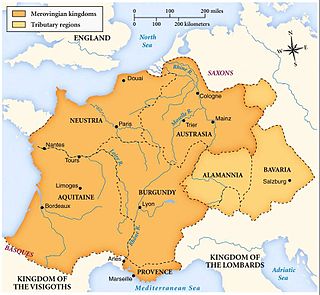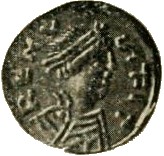
The Merovingian dynasty was the ruling family of the Franks from around the middle of the 5th century until 751. They first appear as "Kings of the Franks" in the Roman army of northern Gaul. By 509 they had united all the Franks and northern Gallo-Romans under their rule. They conquered most of Gaul, defeating the Visigoths (507) and the Burgundians (534), and also extended their rule into Raetia (537). In Germania, the Alemanni, Bavarii and Saxons accepted their lordship. The Merovingian realm was the largest and most powerful of the states of western Europe following the breakup of the empire of Theodoric the Great.

Clovis was the first king of the Franks to unite all of the Franks under one ruler, changing the form of leadership from a group of petty kings to rule by a single king and ensuring that the kingship was passed down to his heirs. He is considered to have been the founder of the Merovingian dynasty, which ruled the Frankish kingdom for the next two centuries. Clovis is important in the historiography of France as "the first king of what would become France."

Chlothar I, sometime called "the Old", also anglicised as Clotaire, was a king of the Franks of the Merovingian dynasty and one of the four sons of Clovis I.

Sigebert I was a Frankish king of Austrasia from the death of his father in 561 to his own death. He was the third surviving son out of four of Clotaire I and Ingund. His reign found him mostly occupied with a successful civil war against his half-brother, Chilperic.
Fredegund or Fredegunda was the queen consort of Chilperic I, the Merovingian Frankish king of Soissons. Fredegund served as regent during the minority of her son Chlothar II from 584 until 597.

Charibert I was the Merovingian King of Paris, the second-eldest son of Chlothar I and his first wife Ingund. His elder brother Gunthar died sometime before their father's death. He shared in the partition of the Frankish kingdom that followed his father's death in 561, receiving the old kingdom of Childebert I, with its capital at Paris.
Hermanfrid was the last independent king of the Thuringii in present-day Germany. He was one of three sons of King Bisinus and his Lombard queen Menia. His siblings were Baderic; Raicunda, married to the Lombard king Wacho; and Bertachar.
Brunhilda was queen consort of Austrasia, part of Francia, by marriage to the Merovingian king Sigebert I of Austrasia, and regent for her son, grandson and great-grandson.

Radegund was a Thuringian princess and Frankish queen, who founded the Abbey of the Holy Cross at Poitiers. She is the patroness saint of several churches in France and England and of Jesus College, Cambridge.
Ingonde, Ingund, Ingunda, or Ingundis was a queen of the Franks by marriage to Chlothar I, son of Clovis.

The Franks were a western European people during the Roman Empire and Middle Ages. They began as a Germanic people who lived near the Lower Rhine, on the northern continental frontier of the empire. They subsequently expanded their power and influence during the Middle Ages, until much of the population of western Europe, particularly in and near France, were commonly described as Franks, for example in the context of their joint efforts during the Crusades starting in the 11th century. A key turning point in this evolution was when the Frankish Merovingian dynasty based within the collapsing Western Roman Empire first became the rulers of the whole region between the rivers Loire and Rhine, and then subsequently imposed power over many other post-Roman kingdoms both inside and outside the old empire.
Amalaberga was the daughter of Amalafrida, daughter of Theodemir, king of the Ostrogoths.

Medardus or Medard was the Bishop of Noyon. He moved the seat of the diocese from Vermand to Noviomagus Veromanduorum in northern France. Medardus was one of the most honored bishops of his time, often depicted laughing, with his mouth wide open, and therefore he was invoked against toothache.
The pagan religion of the Germanic tribal confederation of the Franks has been traced from its roots in polytheistic Germanic paganism through to the incorporation of Greco-Roman components in the Early Middle Ages. This religion flourished among the Franks until the conversion of the Merovingian king Clovis I to Nicene Christianity, though there were many Frankish Christians before that. After Clovis I, Frankish paganism was gradually replaced by the process of Christianisation, but there were still pagans in the late 7th century.
Bisinus was the king of Thuringia in the 5th century AD or around 500. He is the earliest historically attested ruler of the Thuringians. Almost nothing more about him can be said with certainty, including whether all the variations on his name in the sources refer to one or two different persons. His name is given as Bysinus, Bessinus or Bissinus in Frankish sources, and as Pissa, Pisen, Fisud or Fisut in Lombard ones.
Chlothsind was a Frankish princess and the queen consort of the Lombard king Alboin. Her name may also be spelled Chlothsinda, Chlodosinda, Chlodosind, Chlodoswintha or Chlodosuinth.
Ingunde, Ingund, Ingundis or Ingunda, was the eldest child of Sigebert I, king of Austrasia, and his wife Brunhilda, daughter of King Athanagild of the Visigoths. She married Hermenegild and became the first Catholic queen of the Visigoths.
Marcovefa was a Frankish queen consort by marriage to King Charibert I.
Although Merovingian Francia is not considered a slave society, slaves were, nonetheless, present throughout the entirety of the dynasty and well into the Carolingian period and beyond. In the 7th century, however, the sale and trade of Christians within Frankish borders was abolished by Queen Balthild, herself a former slave.
Austregilde, also called Austerchild,Austregildis,Bobilla,Bobile, and Austrechild in most contemporary works and scholarship, was a Frankish queen consort of the Burgundy region in the 6th century. As a woman of the Merovingian elite, Austregilde held a fairly large amount of power, yet this power was limited by Salic law and societal values. As a result, Austregilde and other women needed to exercise their power indirectly through others or through intrigue tactics to become active political players. Understanding Austregilde, the power of elite women and the nature of Merovingian rule requires an analysis of the limited sources available from the contemporary period, like that of the Histories of Gregory of Tours, as well as an understanding of the context surrounding Merovingian rule.









